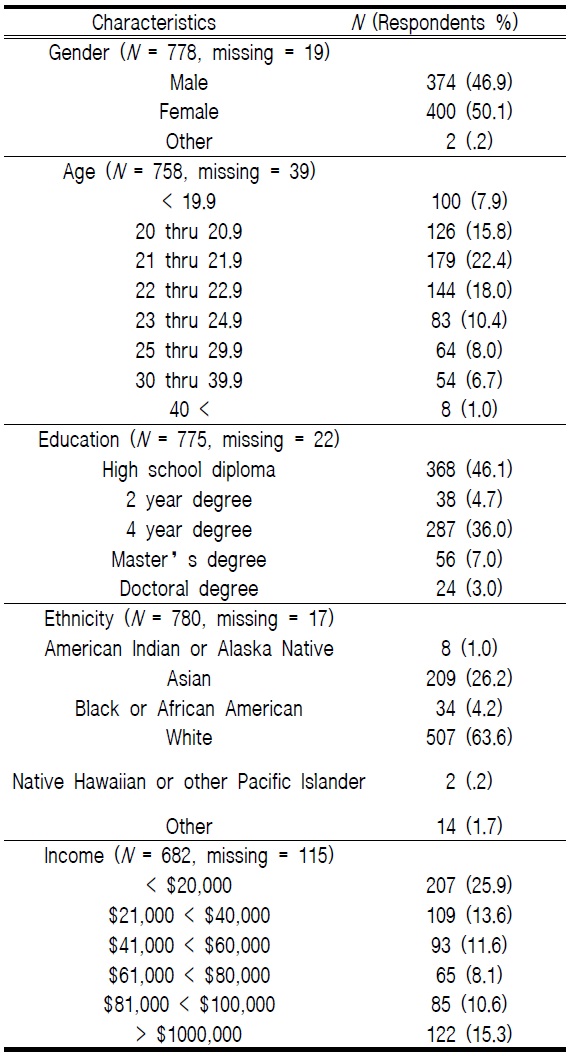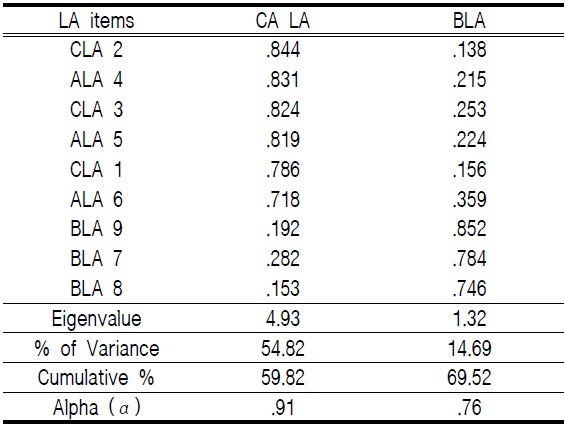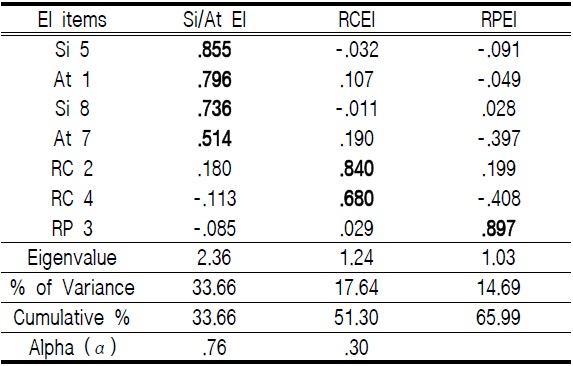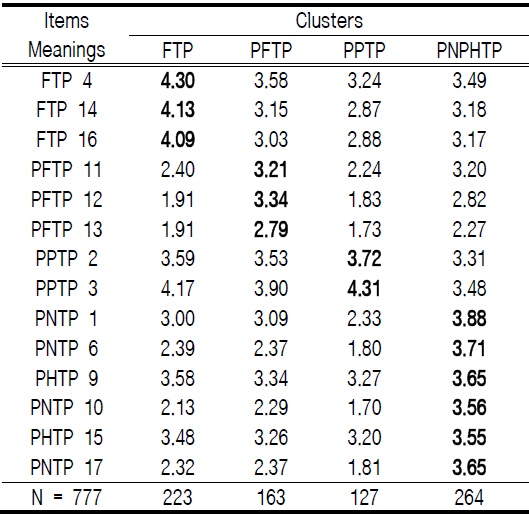


시간관점은 인간의 다양한 관점에 영향을 미치는 것으로 알려져 있다. 하지만, 여가 연구에 있어, 오직 몇 몇연구자들만, 시간 관점이 어떻게 여가선택에 영향을 미치는 가를 보았고, 시간관점과 여가 경험, 즉 여가를 선택한 후, 실제로 경험한 부분에 대한 연구는 부족하다. 이에, 이 연구에서는 시간관점과 여가태도 그리고 지속적 여가관여도와의 관계에 대한 연구를 행하고자 한다. 총 797개의 설문지가 사용되었고, 데이터 분석을 위해, 군집분석과 회귀분석이 사용되었다. 이를 통해 다음의 결과를 산출하였다. 미래적 시간관점은 과시매력 지속적 여가관여도에 긍정적인 영향을 미쳤다. 숙명론자적인 시간 관점은 인지적 정의적 여가태도, 위험 가능성 지속적 여가관여도, 그리고 위험결과 지속적 여가관여도에 부정적인 영향을 미치는 것으로 나타났다. 과거긍정적인 시간관점은 위험 가능성 지속적 여가관여도를 제외한 모든 변인에 긍정적인 영향을 미치는 것으로 나타났다. 과거 부정적, 현실 쾌락적 시간 관점은 과시매력 지속적 여가관여도에는 긍정적인 영향을 위험 가능성 지속적 여가관여도와 위험결과 지속적 여가관여도에는 부정적인 영향을 미치는 것으로 나타났다. 결과들은 개인 맞춤형 여가 프로그램 디자인과 초기 여가 교육의 관점으로 설명하였다.
Researchers have long sought to understand people’s perception of time because tracking time is a basic operation of human development important in the evolution of human cognitive functioning(Suddendorf & Corballis, 1997). The evolving social-cognitive thinking is mainly produced by efficacy beliefs posited in past experiences, current appraisals, and reflections on future opinions and thus widely influences behavioral self-regulation(Bandrua, 1997). When people need to make decisions, they tend to remember similar prior situations that can be nostalgic, positive, ruminative, traumatic, or negative(Zimbardo & Boyd, 1999). Such memory significantly influences current decisions, attitudes, and behaviors as people estimate costs, benefits, and future consequences based on the memory. Subsequently, this thinking process, referred to as Time Perspectives(TPs)(Mead, 1934) and defined as“the totality of the individual’s views of his psychological future and psychological past existing at a given time"(Lewin, 1951, p.75), influences actions and intentions in the present.
TPs are known to be consist of five time biases(Shores & Scott, 2007): a) past-negative, a biased thought to the present in light of a generally unhappy view of the past, b) past-positive, a biased thought to the present in light of a warm, sentimental attitude toward the past, c) present-fatalistic, a biased thought to the present in light of a hopeless attitude toward life, d) present-hedonistic, a biased thought to the present in light of a hedonistic, risk-taking, “devil may care” attitude toward life, and e) future, a biased thought to the present in light of anticipated goals and rewards. These five TPs distinctively and evidently affect a broad spectrum of people’s cognitive and affective processes(Zimbardo, 2002).
For example, a future-oriented person shows less sensation seeking and antisocial behavior, reward dependence, and fewer health risk behaviors(Zimbardo & Boyd, 1999). People with present-oriented TP positively relate to mental health problems, juvenile delinquency, crime, and addictions(Levine, 1997). Presented-oriented people also show the frequent use of alcohol, drugs, and/or tobacco(Zimbardo, 2002) and sensation seeking(Zimbardo & Boyd, 1999). People with past-negative TP are likely to have depression, anxiety, unhappiness, and low self-esteem(Lyubomirsky & Nolen-Hoeksema, 1995). As such, it is evident that TPs relate to individuals’ current attitudes, behaviors, and decisions.
In the leisure literature, however only few studies(e.g., Shores, 2005; Shores & Scott, 2007) directly addressed the aforementioned five TPs, discussing the role of time perspectives in light of wellness, leisure decisions, and recreation preferences. They mainly focused that people make different leisure and recreation decisions according to TPs. Yet, no published study has explicitly discussed how leisure experiences are influenced by TPs once people make their leisure decisions. Given that TPs influence people’s cognitive and affective processes, it is a legitimate assumption that TPs may influence leisure experiences. Thus, the aim of this study was to analyze how leisure experiences are related to TPs using Leisure Attitudes(LAs) and Enduring Involvement(EI).
LAs are defined as people’s particular way of thinking about, feeling about, and acting toward leisure and consists of three dimensions; affective, cognitive, and behavioral LA(Neulinger, 1981). As an attitude is “a learned predisposition to respond in a consistently favorable or unfavorable manner with respect to a given object(Fishbein & Ajzen, 1975, p. 6), using LAs, researchers have studied how people are socialized into leisure and what factors influence the development of positive or negative attitudes about leisure(Hsieh, 1998). Studies found that LAs are associated with self-esteem, perceived freedom, leisure satisfaction, and intrinsic motivation(Siegenthaler & O’Dell, 2000; Stanton-Rich, 1995) and proposed that LA is an important psychological variable in leisure experience. However, no empirical study addressing the relationship between TPs and LAs was found. Thus, this study explored the relationships between TPs and LAs.
EI concept was introduced to leisure literature in 1988 from marketing and consumer-behavior literature(Naylor, 2006). It was posited that recreational activities tend to engender high levels of involvement, and the involvement construct is feasible to assist leisure practitioners’ managerial and marketing decisions(Kyle, Kerstetter, & Guadagnolo, 2002). EI has multidimensional constructs, including: a) attraction, a combination of interest in and pleasure from leisure participation, b) sign, symbolism associated with participation, c) risk probability, associated with choosing one activity over other opinions, and d) risk consequences, associated with a poor choice(Havitz & Mannell, 2005). This multidimensionality can provide insight into the meaning that participants obtain from their leisure experiences and into the underlying motivations of people’s leisure participation. As such, it has been found that there are positive relationships between EI and behavioral loyalty(Iwasaki & Havitz, 2004), psychological commitment(Iwasaki & Havitz, 1998), place attachment(Bricker & Kerstetter, 2000), enthusiasm, and fanaticism(Bloch, 1990). However, EI has not been fully studied in relation to TPs. For all this, this study explored how time perspectives are associated with LAs and EI. Through this study, it was expected to have a better understanding of how individuals’ characteristics(TPs) can influence their leisure experiences and to open the door for the quality individualized leisure experience design.
In addition to socio-demographic items, a questionnaire package was developed by combining three instruments; a) Leisure Attitude Scale(LAS)(Ragheb & Beard, 1982), b) Consumer Involvement Profile(CIP) scale modified by Haviz and Mannell(2005), and c) Zimbardo Time Perspective Inventory(ZTPI)(Zimbardo & Boyd, 1999). All items were rated on a five-point Likert Scale. Although all the instruments had reliability and validity reported in previous studies, a pilot study was conducted to ensure psychometric properties.
The LAS, the modified version of CIP, and the ZTPI were originally developed for 24, 15, and 50 items respectively(a total of 89 items). With 89 items, a pilot test using 67 students in physical activity classes were conducted. Respondents in the pilot study indicated that the questionnaire was lengthy. Thus to reduce the number of items, exploratory factor analyses were conducted on each of three psychological construct using principal component analysis and varimax rotation. From the exploratory factor analyses, items that were placed deviant from what was designed to measure were deleted. Then, items that decreased reliability if the items were deleted were removed to improve scale reliability(i.e., examining positive contributions to scale reliability). As a result, the number of items were reduced to a total of 33 items(17, 9, and 7 items for TPs, LAs, and EI respectively). With the 33 selected items, a questionnaire package was redeveloped.
Nine LA items that were used for the main analysis were “Physical leisure activities can be a means for self-improvement”, “Physical leisure activities help to renew people’s energy”, “Physical leisure activities increase people’s happiness”, “Physical leisure activities give people pleasure”, “Physical leisure activities are refreshing”, “I value physical leisure activities”, “I engage in physical leisure activities even when I am busy”, “I would attend a seminar or a class to be able to do physical leisure activities better”, and “I give physical leisure activities a high priority over other leisure activities.” Seven EI items were “I attach great importance to this activity”, “I will be O.K. even if it is not the best use of my time”, “It is difficult to choose this activity over other leisure activities”, “I will feel bad when it turns out to be a waste of my time”, “My involvement with this activity indicates a lot about me”, “My involvement with this activity is pleasurable”, and “I can really tell a lot about a person if they are involved in this activity.”
The process of data collection is that the primary investigator and data collectors explained the purpose of the research, and respondents were told the confidentiality of participation and their right to not participate in this study. Then questionnaires were distributed to the respondents, and investigators observed them and answered questions that they might have. The questionnaire took around 15 minutes to complete. A total of 909 questionnaires were administered to Kinesiology students or Leisure Studies Students in nine universities, (a) University of Minnesota, (b) University of Toledo, (c) University of Georgia, (d), University of Maryland, (e) Kent State University, (f) University of Kansas, (g) University of Akron, (h) Texas A&M, and (i) University of Tennessee. By participating in this study, students could get extra points from their instructors. Of the 909 distributed questionnaires, considerably incomplete 152 questionnaires were excluded in the main study. Thus a total of 797 questionnaires(84% of initial questionnaires) were used for data analysis. Using descriptive statistics and frequencies, respondents’ characteristics are summarized in <표 1>. The majority of respondents were White(65.0%) and Asian(26.8%), they were in their 표 3. Enduring involvement items 20s, and gender evenly splits(male, 48.1% & female, 51.4%).

연구대상자의 사회인구학적 특성

여가태도 항목들
[표 3.] Enduring involvement items

Enduring involvement items
With 797 questionnaires, exploratory factor analysis was conducted using principal component analysis and varimax rotation to find the subsets of LAs and EI, based on eigen value above one. Two factors from LA items and three factors from EI items were found, named cognitive affective LA(CALA) and behavioral LA(BLA) and sign attraction EI(SAEI), risk probability EI(RPEI), and risk consequence EI(RCEI). Two subsets of LAs showed adequate internal consistency, but the RCEI subset, presented in <표 3>, showed unacceptable internal consistency(Kline, 2000). Thus only the RC2 item was used for following data analysis as this item showed higher factor loading than the RC4 item. The results of factor analysis, and Cronbach’s alpha value for internal consistency are presented in <표 2> and <표 3>.
To cluster respondents based on their TP, Two-Step cluster analysis were used for which three TP constructs were recommended by SPSS. However, when respondents were clustered into three, one of the present fatalistic TP items was misplaced into the present hedonistic/past negative TP cluster. Thus attempts to find better clusters were made and found that assigning six TPs by K-Means cluster analysis was the best because the content of every item rightly corresponded to the characteristic of each cluster. The six clusters were future TP(FTP), present fatalistic TP(PFTP), past positive TP(PPTP), and past negative/present hedonistic TP(PNPH TP) and two “dummy” clusters. This study operationally named two clusters “dummy” because each dummy cluster only contained one respondent, and one respondent cannot constitute and reflect a cluster. Mean scores of cluster analysis were presented in <표 4>. Consequently, the four TP clusters served as independent variables and each of two and three subsets of LAs and EI respectively served as a dependent variable in five individual multiple regression analyses. That is, once cluster analyses categorized subjects into one of four clusters, the relationships between each participant’s mean score of each cluster and his or her score of each subset of LAs and EI were examined. For example, among participants with FTP, some may have 3.5 FTP score on average of three FTP items and 4.2 BLA score on average of three BLA items, or others may have 4.6 FTP score on average of three FTP items and 4.9 BLA score on average of three BLA items. Given that high mean FTP scores represent those who have stronger FTP tendencies, multiple regression analyses were conducted to understand the influences from FTP tendencies to BLA levels.
[표 4.] Mean scores of clusters

Mean scores of clusters
Findings suggested that cognitive affective LA was positively related to past positive TP and negatively related to present fatalistic TP. Based on standardized coefficient values, past positive TP influenced cognitive affective LA more so than present fatalistic TP. Behavioral LA was only positively related to past positive TP. Sign attraction EI was positively related to future TP, past positive TP, and past negative present hedonistic TP. Amongst the TP variables, past positive TP most positively influenced sign attraction EI. Risk probability EI was negatively related to present fatalistic TP and past negative present hedonistic TP. Risk consequence EI was negatively related to present fatalistic TP and past negative present hedonistic TP, but showed a significant positive relationship to past positive TP. Overall, multicollinearity issues were not found as the average VIF was not substantially larger than 1 and Tolerance values were not below 0.2(Bowerman & O’Connell, 1990; Menard, 1995). In addition, variances explained by TP variables was low because low values of R square were found(5.3% for CALA, 3.4% for BLA, 7% for SIATEI, 4% for RPEI, 3% for RCEI), presented in <표 5>.

Multiple Regression Analysis from Time Perspectives to Enduring Involvement and Leisure Attitude
Finding suggests that Time Perspectives (TPs) are important influential variables to Leisure Attitudes (LAs) and Enduring Involvement (EI). Past positive TP can be considered the most important in association with LAs and EI because positive relationships between past positive TP and all the subsets of LAs and EI were found, only except for risk probability EI. In addition, the importance of past positive TP was elucidated as it most contributes to enhancing LAs and EI, compared to other TPs, based on standardized coefficients. That is, those who have a stronger warm sentimental attitude toward the past are likely to have more positive attitudes to leisure in general and a stronger attachment to a currently participating leisure activity as LAs are closely related to general attitudes to leisure activities and as EI was more concerned to specific involvement with a currently participating activity. Thus, if we understand how we promote past positive TP, we may find a way to help people to have more benefits from their leisure experiences.
In the flip side, we need to find how not to promote present fatalistic TP and past negative present hedonistic TP because these TPs showed significant negative relationships to LAs and EI, which can subsequently hinge people from benefiting from their leisure experiences. It is interesting that past negative present hedonistic TP showed a significant positive relationship to sign attraction EI, other than that in the opposite direction. Future research endeavors may be directed to investigate this.
Plus, it is worth to note that risk-related EI was not clearly factorized in this study sample. This could be partially due to the number of participants in the pilot study of this study. Principal components analysis has been an important tool for researchers to reduce variable redundancy, but this analysis is often considered arbitrary because there is no way to calculate the probability of making an error of inference. As a result, there is no ubiquitously accepted rule in terms of sample size for principle component analysis. However, generally, larger samples are better than smaller samples as this may result in the reduction of the probability of errors. But the inflation of Type II error is a likely tied concern. With this in mind, a few researchers explored recommended sample sizes for principle component analysis and exploratory factor analysis. They suggested absolute minimum sample sizes ranging from 50(Barrett & Kline, 1981) to 400(Aleamoni, 1976). Although a pilot study is referred to as “small scale version[s], or trial run[s], done in preparation for the major study"(Polit et al., 2001: p. 467), the number of participants (n = 67) in the pilot study of this study needs to be noted as it barely met the suggested minimum sample size. Subsequently, the small sample size might be the reason risk-related EI was not clearly factorized.
Another possible explanation of nonfactorized risk-related EI construct is that the measurement of risk involvement has been problematic in previous leisure studies(Havitz & Dimauclie, 1997). Given that the voluntary nature of leisure activities, people tend to not participate in any risk-involved leisure activities as leisure activities are different than purchasing a product in on-line. This idea is more manifested when considering leisure involvement scales was originated from consumer marketing research.
In addition, only one item was used to measure each of two risk-related EI constructs. One item might not well represent a subset of EI constructs, but adding poor quality items would actually increase error and lower reliability. Thus in this study sample, using one item would be beneficial to understand each subset of risk-related EI constructs. This poor internal consistency of risk-related EI items needs to be reexamined in future research. For all this, it is necessary to cautiously interpret the findings of the relationships between TPs and subsets of EI.
The role of TP constructs in leisure experiences is found through this study. Given that leisure activities are beneficial to participants and given that LAs and EI are important variables in leisure experiences, past positive and future TP can be considered “good and healthy TP” because respondents with those TP showed positive relationships to LAs and EI. Conversely, present fatalistic TP can be considered “bad and unhealthy TP” because respondents with those TP showed negative relationships to LAs and EI. Future research endeavors need to be directed to change people’s biased thoughts from a unhappy view of the past (past negative TP), a hopeless attitude toward current life (present fatalistic TP), and a “devil may care” attitude (present hedonistic TP) to people’s biased thoughts to a positive attitude toward the past (past positive TP). This finding may provide an important implication to how we can design early leisure education. Also, given that leisure participants’ experiences differ according to TPs, understanding each participant TP can provide a basic means to individualize leisure services, and participants’ satisfaction to the given leisure services would be followed. Finally, more studies addressing TPs and leisure-related psychological variables such as leisure constraints, serious leisure, and motivation will lead us to a better understanding of leisure experiences.




